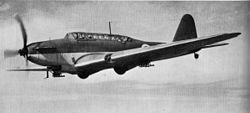RAF Advanced Air Striking Force
| RAF Advanced Air Striking Force | |
|---|---|

A Fairey Battle
|
|
| Active | 24 August 1939 – 26 June 1940 |
| Country | United Kingdom |
| Type | Advanced Air Striking Force |
| Engagements | Battle of France |
| Commanders | |
| Current commander |
Air Vice-Marshal P. H. L. Playfair |
| Aircraft flown | |
| Bomber |
Fairey Battle Bristol Blenheim |
| Fighter | Hawker Hurricane |
Before the Second World War it had been agreed between the United Kingdom and France that in case of war, the light bomber force of the Royal Air Force would move to airfields within France from which it could operate against targets in Nazi Germany. To achieve this, the RAF Advanced Air Striking Force (AASF) was formed on 24 August 1939 from No. 1 Group, and its ten squadrons of Fairey Battles dispatched to airfields in the Rheims area on 2 September 1939.
It was an independent command from the British Expeditionary Force and at first reported directly to the Air Ministry. However this arrangement proved to be inadequate and on 15 January 1940 it was placed under the command of the British Air Forces in France headquarters. That headquarters also took the Air Component of the British Expeditionary Force under its command. Air Vice-Marshal Arthur Barratt commanded the British Air Forces in France.
Political considerations prevented the use of the AASF against Germany and it only saw action once the Germans attacked in the west in May 1940.
The AASF then consisted of eight squadrons of Battles, two squadrons with Bristol Blenheim medium (by the standards of 1940) bombers, and two squadrons of Hawker Hurricane fighters, to be reinforced by a further squadron of Hurricanes in response to any major military action.
At the start of 10 May, the AASF had 135 serviceable bombers, whereas the French Armee de l'Air had less than 100 bombers, only a quarter of which were not obsolescent.
The operational instructions issued by BAFF had stated that
Bomber aircraft have proved extremely useful in support of an advancing army, especially against weak anti-aircraft resistance, but it is not clear that a bomber force used against an advancing army well supported by all forms of anti-aircraft defence and a large force of fighter aircraft, will be economically effective
...
Wikipedia
